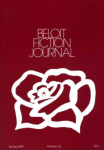Congratulations to Co-Editors and proud parents Tanner Higgin and Christopher Vieau on the birth of their child, The Means. The Means, a Michigan native, at once temperamental and charming, incubated for a full two years, paralleling the gestation period of an elephant. In concert with the already unraveling mammalian theme, Higgin writes, in his Editor’s Note, “This first issue contains a virtual Noah’s ark of writers […] absolutely necessary in our rebellion against the literary establishment.” Their complaint? Scarcity of literary journals willing to publish the risqué and the silly, which is exactly what they set out to do. The Means’s debut issue presents readers with seductive ideas in newfangled form. Rebecca Brown’s hyper-experimental essay “The Reading of Water: Subjective Surging Based on Graham Swift’s Waterland” simultaneously annoys and dazzles readers with its meandering style. But Brown ultimately comments steeply, I think, and not un-clearly, on time and its relevance—or irrelevance—to narrative. C.L. Bledsoe’s is-it-a-poem “What To Do In Case of a Locked Door” reads like a set of fold-out directions, making sense even without those tiny useless diagrams. As much sense as preparatory advice for a locked door situation can make. Both pieces are delightful endeavors, and they aren’t on their own. Admittedly, The Means is a new kid on the block, a strange new kid, both in approach and tenor, in a subdivision of more traditionally ‘serious’ journals. In a recent interview, Kim Addonizio commented on this strange new-ish approach to poetry: “earnestness […] to get at that from a different way, irony through humor, some kind of movement sideways.” The Means line dances its way to the dignity it already knows it deserves.
[The Means, P.O. Box 183246, Shelby Township, MI 48318. Single issue $8.]

